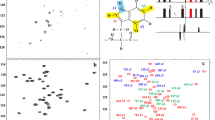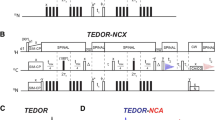Abstract
Experiments detecting low gyromagnetic nuclei have recently been proposed to utilize the relatively slow relaxation properties of these nuclei in comparison to 1H. Here we present a new type of 15N direct-detection experiment. Like the previously proposed CaN experiment (Takeuchi et al. in J Biomol NMR 47:271–282, 2010), the hCaN experiment described here sequentially connects amide 15N resonances, but utilizes the initial high polarization and the faster recovery of the 1H nucleus to shorten the recycling delay. This allows recording 2D 15N-detected NMR experiments on proteins within a few hours, while still obtaining superior resolution for 13C and 15N, establishing sequential assignments through prolines, and at conditions where amide protons exchange rapidly. The experiments are demonstrated on various biomolecules, including the small globular protein GB1, the 22 kDa HEAT2 domain of eIF4G, and an unstructured polypeptide fragment of NFAT1, which contains many SerPro sequence repeats.




Similar content being viewed by others
References
Bermel W, Bertini I, Felli IC, Kummerle R, Pierattelli R (2006a) Novel C-13 direct detection experiments, including extension to the third dimension, to perform the complete assignment of proteins. J Magn Reson 178:56–64
Bermel W, Bertini I, Felli IC, Lee Y-M, Luchinat C, Pierattelli R (2006b) Protonless NMR experiments for sequence-specific assignment of backbone nuclei in unfolded proteins. J Am Chem Soc 128:3918–3919
Bermel W, Bertini I, Felli IC, Piccioli M, Pierattelli R (2006c) C-13-detected protonless NMR spectroscopy of proteins in solution. Prog Nucl Magn Reson Spectrosc 48:25–45
Bertini I, Luchinat C, Parigi G and Pierattelli R (2008) Perspectives in paramagnetic NMR of metalloproteins. Dalton Trans 29:3782–3790
Cai S, Seu C, Kovacs Z, Sherry AD, Chen Y (2006) Sensitivity enhancement of multidimensional NMR experiments by paramagnetic relaxation effects. J Am Chem Soc 128:13474–13478
Cavanagh J, Fairbrother WJ, Palmer AG, Skelton NJ (1996) Protein NMR Spectroscopy: principles and practice. Academic Press, San Diego
Emsley L, Bodenhausen G (1992) Optimization of shaped selective pulses for NMR using a quaternion description of their overall propagators. J Magn Reson 97:135–148
Ernst RR, Bodenhausen G, Wokaun A (1987) Principles of nuclear magnetic resonance in one and two dimensions. Oxford Univ Press, London/New York
Felli IC, Brutscher B (2009) Recent advances in solution NMR: fast methods and heteronuclear direct detection. Chem Phys Chem 10:1356–1368
Frueh DP, Arthanari H, Wagner G (2005) Unambiguous assignment of NMR protein backbone signals with a time-shared triple-resonance experiment. J Biomol NMR 33:187–196
Hoult DI (1978) The NMR receiver: a description and analysis of design. Prog Nucl Magn Reson Spectrosc 12:41–77
Howarth OW, Lilley DMJ (1978) Carbon-13-NMR of peptides and proteins. Prog Nucl Magn Reson Spectrosc 12:1–40
Hyberts SG, Takeuchi K, Wagner G (2010) Poisson-gap sampling and forward maximum entropy reconstruction for enhancing the resolution and sensitivity of protein NMR data. J Am Chem Soc 132:2145–2147
Hyberts SG, Wagner AB, Milbradt A, Arthanari H, Wagner G Fast reconstruction by iterative soft thresholding of multidimensional non-uniformly sampled NMR data sampled with multidimensional poisson gap scheduling (to be published)
John M, Park AY, Dixon NE, Otting G (2007) NMR detection of protein N-15 spins near paramagnetic lanthanide ions. J Am Chem Soc 129:462–463
Kupce E, Freeman R (1995) Adiabatic pulses for wideband inversion and broadband decoupling. J Magn Reson A 115:273–276
Lee D, Vogeli B, Pervushin K (2005) Detection of C‘ C-alpha correlations in proteins using a new time- and sensitivity-optimal experiment. J Biomol NMR 31:273–278
Levitt MH (2001) Spin dynamics. Wiley, New York
Levy GC, Lichter RL (1979) Nitrogen-15 nuclear magnetic resonance spectroscopy. Wiley, New York
Lin IJ, Xia B, King DS, Machonkin TE, Westler WM, Markley JL (2009) Hyperfine-shifted C-13 and N-15 NMR signals from Clostridium pasteurianum rubredoxin: extensive assignments and quantum chemical verification. J Am Chem Soc 131:15555–15563
Mantylahti S, Aitio O, Hellman M, Permi P (2010) HA-detected experiments for the backbone assignment of intrinsically disordered proteins. J Biomol NMR 47:171–181
Marintchev A, Edmonds KA, Marintcheva B, Hendrickson E, Oberer M, Suzuki C, Herdy B, Sonenberg N, Wagner G (2009) Topology and regulation of the human eIF4A/4G/4H helicase complex in translation initiation. Cell 136:447–460
Marion D, Ikura M, Tschudin R, Bax A (1989) Rapid recording of 2d Nmr-spectra without phase cycling—application to the study of hydrogen-exchange in proteins. J Magn Reson 85:393–399
Mishkovsky M, Frydman L (2004) Sensitivity enhancement in 1D heteronuclear NMR spectroscopy via single-scan inverse experiments. Chem Phys Chem 5:779–786
Morris GA, Freeman R (1979) Enhancement of nuclear magnetic resonance signals by polarization transfer. J Am Chem Soc 101:760–762
Pervushin K (2000) Impact of transverse relaxation optimized spectroscopy (TROSY) on NMR as a technique in structural biology. Q Rev Biophys 33:161–197
Pervushin K, Riek R, Wider G, Wuthrich K (1997) Attenuated T-2 relaxation by mutual cancellation of dipole–dipole coupling and chemical shift anisotropy indicates an avenue to NMR structures of very large biological macromolecules in solution. Proc Natl Acad Sci USA 94:12366–12371
Pervushin K, Vogeli B, Eletsky A (2002) Longitudinal (1)H relaxation optimization in TROSY NMR spectroscopy. J Am Chem Soc 124:12898–12902
Schanda P, Kupce E, Brutscher B (2005) SOFAST-HMQC experiments for recording two-dimensional heteronuclear correlation spectra of proteins within a few seconds. J Biomol NMR 33:199–211
Shaka AJ, Keeler J (1987) Broadband spin decoupling in isotropic liquids. Prog Nucl Magn Reson Spectrosc 19:47–129
Takeuchi K, Sun ZY, Wagner G (2008) Alternate 13C–12C labeling for complete mainchain resonance assignments using C alpha direct-detection with applicability toward fast relaxing protein systems. J Am Chem Soc 130:17210–17211
Takeuchi K, Heffron G, Sun ZYJ, Frueh DP, Wagner G (2010) Nitrogen-detected CAN and CON experiments as alternative experiments for main chain NMR resonance assignments. J Biomol NMR 47:271–282
Tamiola K, Mulder FAA (2011) ncIDP-assign: a SPARKY extension for the effective NMR assignment of intrinsically disordered proteins. Bioinformatics 27:1039–1040
Tompa P (2003) Intrinsically unstructured proteins evolve by repeat expansion. Bioessays 25:847–855
Tugarinov V, Hwang PM, Ollerenshaw JE, Kay LE (2003) Cross-correlated relaxation enhanced 1H–13C NMR spectroscopy of methyl groups in very high molecular weight proteins and protein complexes. J Am Chem Soc 125:10420–10428
Vance CK, Kang YM, Miller AF (1997) Selective N-15 labeling and direct observation by NMR of the active-site glutamine of Fe-containing superoxide dismutase. J Biomol NMR 9:201–206
Vasos PR, Hall JB, Kummerle R, Fushman D (2006) Measurement of N-15 relaxation in deuterated amide groups in proteins using direct nitrogen detection. J Biomol NMR 36:27–36
Venters RA, Huang CC, Farmer BT, Trolard R, Spicer LD, Fierke CA (1995) High-Level H-2/C-13/N-15 labeling of proteins for Nmr-Studies. J Biomol NMR 5:339–344
Wang AC, Grzesiek S, Tschudin R, Lodi PJ, Bax A (1995) Sequential backbone assignment of isotopically enriched proteins in D2O by deuterium-decoupled HA(CA)N and HA(CACO)N. J Biomol NMR 5:376–382
Wuthrich K, Wagner G (1979) Nuclear magnetic resonance of labile protons in the basic pancreatic trypsin inhibitor. J Mol Biol 130:1–18
Xu J, Millet O, Kay LE, Skrynnikov NR (2005) New spin probe of protein dynamics: Nitrogen relaxation in N-15-H-2 amide groups. J Am Chem Soc 127:3220–3229
Zhou P, Lugovskoy AA, Wagner G (2001) A solubility-enhancement tag (SET) for NMR Studies of poorly behaving proteins. J Biomol NMR 20:11–14
Acknowledgments
This research was supported by the NIH grants GM047467, AI037581 and CA127990. Maayan Gal would like to thank the Human Frontier science Program (HFSP) for a postdoctoral fellowship. The authors would like to thank Dr. Gregory Heffron for fruitful discussions and technical assistance with the 15N direct detection setup.
Author information
Authors and Affiliations
Corresponding author
Additional information
Katherine A. Edmonds and Alexander G. Milbradt have contributed equally.
Electronic supplementary material
Below is the link to the electronic supplementary material.
Rights and permissions
About this article
Cite this article
Gal, M., Edmonds, K.A., Milbradt, A.G. et al. Speeding up direct 15N detection: hCaN 2D NMR experiment. J Biomol NMR 51, 497–504 (2011). https://doi.org/10.1007/s10858-011-9580-7
Received:
Accepted:
Published:
Issue Date:
DOI: https://doi.org/10.1007/s10858-011-9580-7




